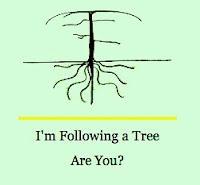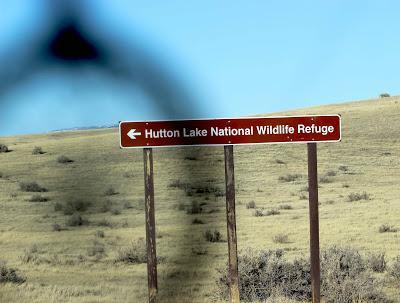
I zipped up my jacket, put on my pack, pulled the camera out of the case … and was hit by that sinking feeling that still surfaces even though we humans left the dangerous bush long ago. I had the wrong lens! Should I venture into the wilds of the Laramie Basin armed only with a mid-range telephoto?It was an exceptional February day: 52º F, virtually no wind. Surely a camera wasn't necessary to enjoy the spring weather, expansive landscapes, and ice patterns on the frozen lakes. I walked west along a dirt road, stopping now and then to photograph ice and other things that fit in the field of the 100 mm lens.
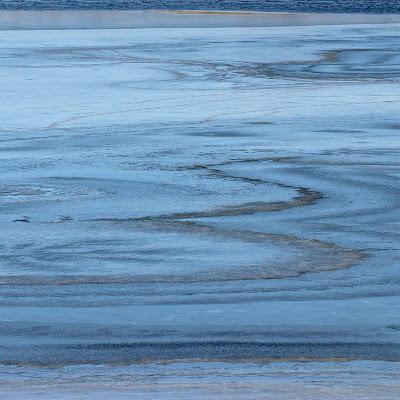
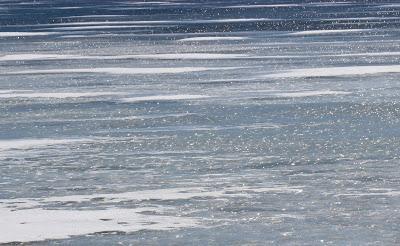
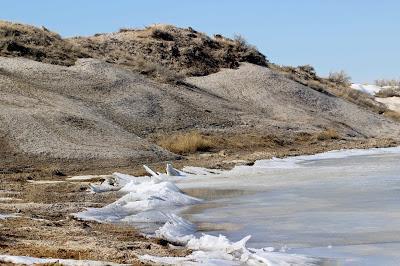
Ice slabs and salt-encrusted mud in front of a brown snow bank (windblown dirt).
These lakes sit in a large depression in the southern part of the Laramie Basin. They're fed by creeks and irrigation canals, but there’s no way for the water to leave aside from evaporation. This is one of the reasons they're “alkali.” Technically the lakes are saline, not alkaline, but people around here would look at you strange if you said Hutton Lake was saline. Whatever the term, it's immediately obvious—by the distinctive smell and the white crusty dried mud along the margins.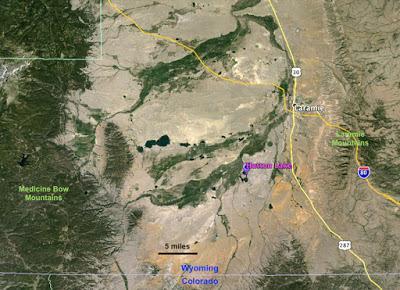
Hutton Lake lies in the Laramie Basin SSW of Laramie (Google Earth; click on image to view details).
We may find alkali wetlands smelly and distasteful, but they're important habitat. Salt-tolerant terrestrial and aquatic invertebrates thrive here, providing tasty and nutritious bird food. For much of the year, the Refuge is popular with birds (146 species have been reported) and the attendant birders.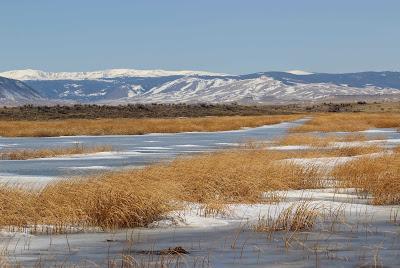
Bulrushes in Hutton Lake; Medicine Bow Mountains and the Snowy Range behind.
But currently the lakes are still mostly frozen. There are few birds and even fewer human visitors, aside from an occasional nature lover suffering from cabin fever.I was at Hutton Lake National Wildlife Refuge in search of juneberries, aka sarvice or service berries, saskatoon, amelanchier and more. I want to follow one this year. (Unfamiliar with tree-following? Read more here.) There are two juneberry specimens from Hutton Lake in the Rocky Mountain Herbarium, but as I walked through saltgrass meadows, alkali wetlands and stands of greasewood, I felt like a sucker. The uplands nearby were no more promising—heavily-grazed grassland full of prickly pear cactus. There were no trees anywhere. I saw nothing that looked like potential habitat for juneberries. They are moist-woodland trees needing adequate water, and it has to be sweet, not alkaline.At the west end of the lake near the Refuge boundary, I walked to a high point (by about six feet) to plan a return route. In the distance, I spotted ... another visitor! A man walked slowly my way, stopping to scan the lake with binoculars. I assumed he was a birder, and maybe a well-rounded naturalist as well. Maybe he would know where the juneberries grow.As we approached, I waved; he waved back. Closer, I saw he wore a broad-brimmed felt hat, day-pack, and canvas jacket, all in subdued colors—greens and browns. He used a walking stick. Then when we were close enough to speak, I started laughing. So did he. That’s what you do when you meet someone you know in the middle of nowhere.I explained my mission, expecting more laughter, but Tom immediately replied, “Oh yeah, I know where the juneberries grow. See that knob? [pointing with walking stick] They’re on the slope below. There are some small cottonwoods too, and willows. Just walk across the causeway.”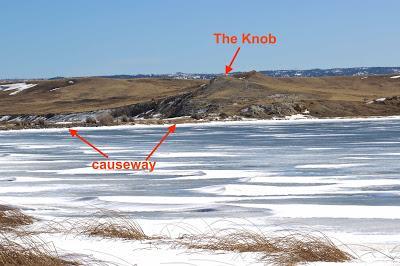
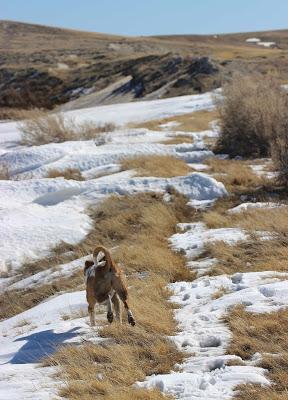
Does the causeway lead to where the juneberries grow?
From the end of the causeway, I made my way along the lakeshore through snow, mud and grass. I was skeptical. But then … there they were, a cluster of small juneberry trees! … maybe. They were barely large enough to have striated bark, needed for winter identification.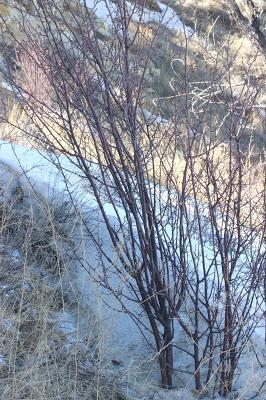
Juneberry "trees"?
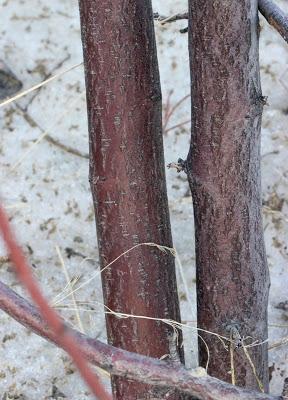
The one on the right looks more promising.
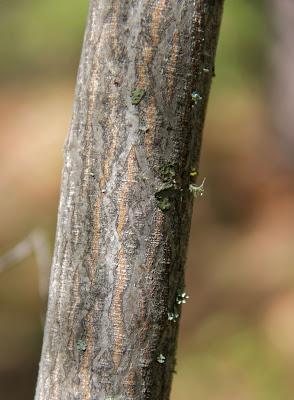
For comparison: mature Amelanchier alnifolia in the Black Hills.
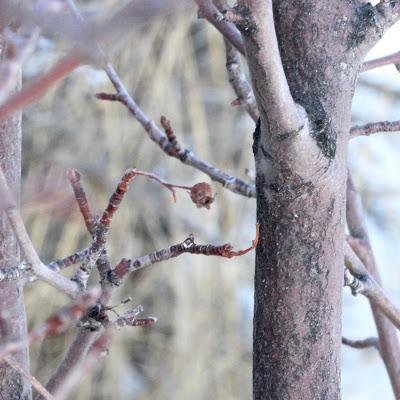
This old dried fruit looks like a juneberry.
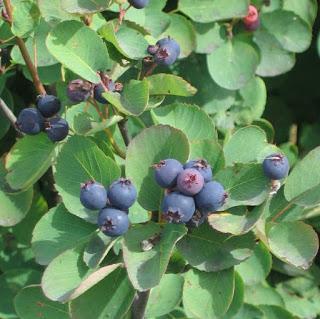
Ripe juneberries for comparison. Photo by Meggar.
I also found the cottonwoods and willows that Tom mentioned, as well as some aspen, all within an area of less than 300 square meters. What an interesting spot—something makes it just right for a tiny woodland.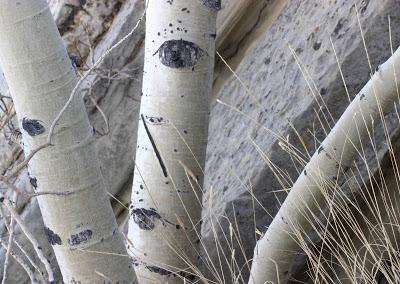
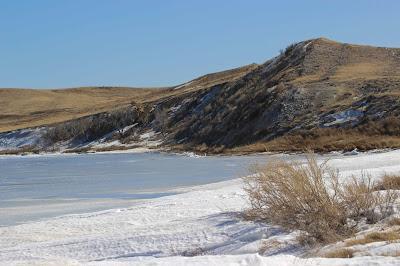
Trees are on the shady slope below and left of the Knob's summit.
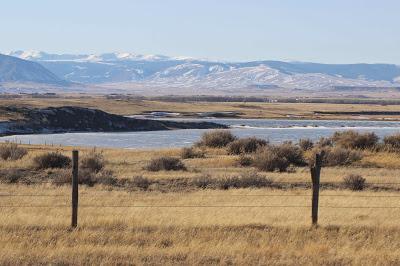
The Laramie Basin, with the Medicine Bow Mountains and Snowy Range beyond. Hutton Lake is mid-photo, the Knob on the left and causeway on the right.
I love Nature's puzzling surprises! So even though it's barely a tree, I think I will follow this juneberry—if that’s indeed what it is. Stay tuned.